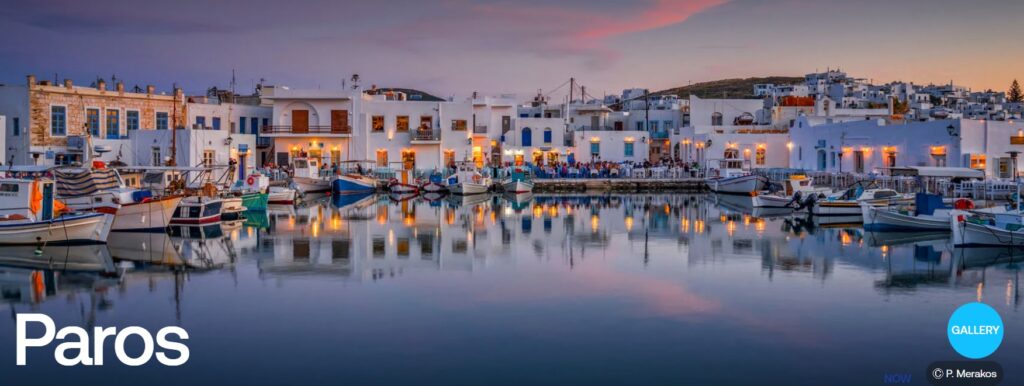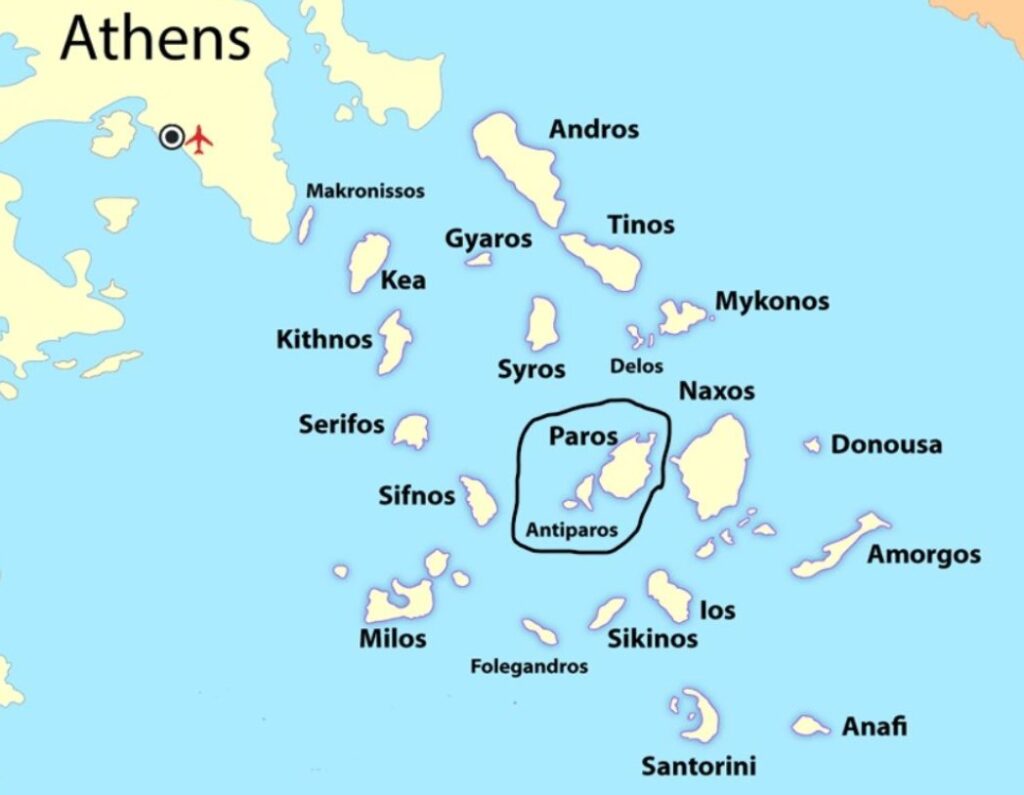Getting here was a 50 minute ferry ride from Mykonos (which was delayed multiple times). The ferry itself was great, a speedy catamaran with comfortable seats.
A side note here is that virtually every ferry that we have booked has had numerous changes (of either ship or time). Because of this, the original seat allocation may as well be thrown in the bin before you even start. They will find you a couple of spare seats and sit you down. This is fine if there are just 2 of you, but becomes a nightmare for large groups who want to sit together.

Paros became famous for its white marble called ‘Parian marble’. This is a fine-grained semi translucent pure-white and entirely flawless marble and was mainly quarried here during the classical era (500-336BC).
This marble was used in both architecture and sculpture. Some of the masterpieces of ancient Greek sculpture were made with this pure white, translucent material. Notably these include (L-R): The statues of Hermes by Praxiteles, Venus de Milo (i.e. Aphrodite of Milos), Nike [Winged Victory] of Samothrace, and the Caryatids, (the pillars holding up the patio of the Erechtheion on the Acropolis).




As soon as we arrived on Paros, I knew that I would love this place. It had all of the beauty of Mykonos (without the huge prices and plastic people) and Syros (without the stairs). We settled into our hotel and went for a late afternoon stroll, which turned into a few beers watching the sunset. And followed onto a dinner on the waterfront promenade.









Paros is one of the bigger of the Cycladic islands and it offers the same narrow streets, bougainvillea covered buildings, seaside promenades, cafes, restaurants and beaches as most of the other more famous islands of the region.

Parikia is the capital town and main port of Paros, as well as the centre of commercial and cultural life (and our home for the next few days).
There are no big resorts here. Your only option is staying at a smaller family-owned type hotel. We somehow managed to get the one that takes tour buses of 18-25 year olds doing the Greek islands tour. This meant that every 2 days a new busload of around 50 noisy millennials would turn up. On average about 30 of that 50 were Aussie girls. The early pool infestation was loud and noisy in the afternoons, but they all headed out to the promenade for sunset and partied into the evening. Our next real interaction was the next morning when we heard the moaning as they dealt with their hangovers.


Given the size of the island, the next day we chose to hire a car and see all the extra bits that were tough to reach. This was new for us as usually we just wander around or hire motorcycles or scooters. Add to this it was a left hand drive, driving on the right, mad-ass Greek drivers, a 1 litre Peugeot with no power, no ability to read Greek and no real idea where we were going. So that was us – and off we went.
Our first major stop was the town of Lefkes where we wandered the small narrow streets until we found ourselves at the main church of Agia Triada (Holy Trinity), built in 1830. We did stop at a tiny (any guesses?) blue and white church along the way.









From here we found ourselves at a local winery where Jill proceeded to sample the wares. Given that I was driving and I had enough going on I chose not to partake. But the wines were nice and the setting was very nice indeed.





We saw the church of Agios Ioannis (Saint John) Detis (built in the 17th century). It was very nice, but when in Greece the sight of a whitewashed church with a blue domed roof is a dime a dozen and you pass one every 10 minutes or so on the road. A few more stops saw us checking in at Lageri Beach, Santa Maria Beach and driving through millionaires row (on the other side of the island) where there are some truly stunning villas (obviously holiday homes for the rich and famous). The most striking thing that we saw was the quality of the stonework that was in place all around the island. Masonry in Greece is not a dying art and is alive and well.







Just across the way from Paros is the island of Antiparos. This had me imagining some evil twin scenario where one had turned and had become evil. In fact, it is one of those Greek islands that had managed to stay off the radar. I say had because several years ago the actor Tom Hanks bought a block of land and built a villa. Since then, he and a range of other “A-listers” have been regularly visiting. According to locals, he has done a lot of good (improving hospitals etc) but the prices have gone up 400% since he arrived. So now many of the Antiparos locals live on Paros and catch the ferry over to run their businesses.
After a half day of driving (only about 120km), we had circumnavigated the island, including some off-roading (in our 1 litre monster) to the choice photo spots. And we had seen all the bits there was to see. Long story short, this place is amazing.



The next day we hopped on the local the bus and headed to the town of Naousa. This is the more popular town about 9km up the road. Well we soon worked out where all the vacuous people had gone to. This is a really pretty tourist town whose streets are awash with Instagrammers all posing for their shots. You could see why though, the streets were pristine and it was set up for the tourists. Oh, and there were ducks.








One of the more amusing sights was when two groups of Instagrammers met and everyone needed shots of the same location. Oh, the Mexican standoff that ensued. The other thing that I have learned on this trip is the VERY different demands that are placed on boyfriends in 2023. No longer is being a loving and supportive partner enough, now you must have done a photography course and be patient enough to take endless photos of your girlfriend’s back while she peers over her own shoulder back towards you.
On the tourism front, there is a small Venetian Castle that was built in the 15th century perched on the end of the old port and the blue-domed chapel of St. Nikolas. You can walk across a tiny causeway (about 60cm wide) to the castle, but must navigate the crashing waves and vicious winds in doing so.





From here we headed back to Parikia and figured that we had better check out the tourist spots where we were staying as all we had really done was enjoy the food, cafes, restaurants, and the promenade. So we saw the Monastery of Panagia Ekatontapiliani (the Virgin Mary of the Hundred Doors), the Pamegiston Taksiarxon (another blue-domed, whitewashed church), another windmill, and the (very unimpressive) Frankish castle (built in 1260 by the Venetians).






OK, so I think that this is our favourite of the Greek Islands so far. It is very scenic, well priced, relatively flat (so that you don’t have to kill yourself going up and down stairs) and has a nice local feel to it while still catering well to the tourists. If you want the super pretty and Instagram world head up the road to Naousa, for the more relaxed version, stay in Parikia, and if you want the private retreat, rent a villa.